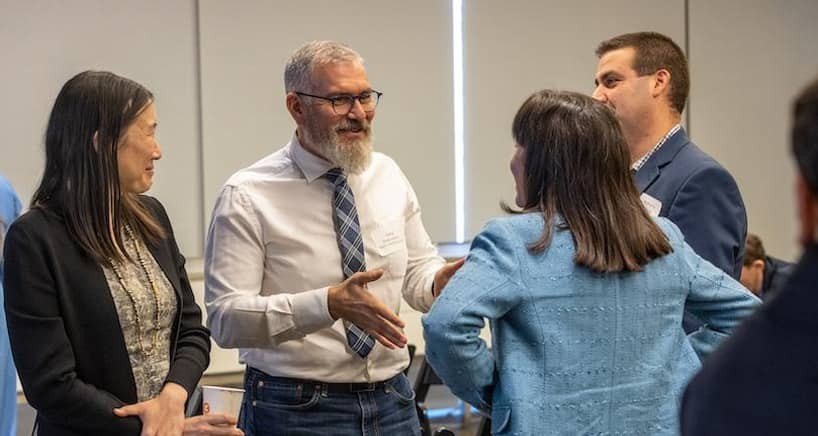These Startups Aim to Revolutionize Health Care and Tech

Columbia Technology Ventures’ pitch day gives center stage to startups emerging from the labs to the boardroom.
On Oct. 19, 31 startups and over a hundred investors gathered at Goodwin Procter LLP in the New York Times Building for the Columbia Technology Ventures (CTV) Annual Pitch Day. This year, CTV partnered with Johns Hopkins University (JHU) to showcase startups emerging from the research labs of Columbia and JHU. During a morning of fast-paced 10-minute pitches, presenters had the opportunity to captivate investors with their projects, categorized into two tracks. Track 1 centered on therapeutics, diagnostics, and platforms, while Track 2 included physical sciences, devices, health tech, sensors, and data science startups.
In opening remarks, Orin Herskowitz, executive director at CTV, highlighted the significant commercial successes stemming from inventions at both Columbia and Johns Hopkins. These two universities jointly produce approximately 870 inventions each year from their faculty, according to Herskowitz.
“As you can see, it's a huge expansion of startups getting started. And they're not just getting started. They’re thriving,” he said. In the past five years alone, startups born out of Columbia have secured an impressive $3 billion in funding.
Shih-Fu Chang, dean of Columbia Engineering, underlined the importance of innovation, translation, and entrepreneurship, combining innovation in the labs with business savvy.
To further support entrepreneurship and leadership, Columbia Engineering has recently started a new dual degree program between the Engineering School and Columbia Business School. Students earn an MBA as well as a master’s degree in engineering after 24 months of intensive training.
At Pitch Day, eight teams spun out from Columbia Engineering labs presented. Here, we showcase just a few of the technology and engineering innovations that took center stage.
Kampto Neurotech
Kampto Neurotech has developed a cutting-edge wireless brain-computer interface (BCI) device that sits on the surface of the brain in a region known as the subarachnoid space under the skull. The device, which takes the form of a mechanical flexible integrated circuit chip, offers more than 65,000 electrodes for stimulating and recording from the brain. The chip communicates with and is powered by a small wearable device, called a relay station, which is itself a WiFi device. “It's like a WiFi connection to your brain,” said Ken Shepard, Lau Family Professor of Electrical Engineering and professor of biomedical engineering at Columbia Engineering, “But it doesn't require any wires or any connection through the skull. It can be inserted directly under the skull without producing any damage to cortical tissue.” Shepard and his lab at Columbia focus on bioelectronics for many applications from molecular diagnostics to brain imaging.
Currently undergoing pre-clinical testing, Kampto Neurotech is now conducting comprehensive pre-clinical tests in two large animal models, and is progressing towards the permission for first-in-human trials. Their device boasts a wide range of potential applications, including the treatment of blindness and aphasia.
OptiCardio
Cardiac radiofrequency ablation succeeds in less than 50% of cases for complex heart rhythm issues like atrial fibrillation and ventricular tachycardia. Current procedures fall short due to ineffective tissue damage, resulting in recurrent problems. A new reliable approach is urgently needed to pinpoint treatment areas and ensure better outcomes for personalized therapy. OptiCardio revolutionizes cardiac radiofrequency ablation, aiming to increase its success rate. Spearheaded by Christine P. Hendon, associate professor of electrical engineering, OptiCardio is addressing two large and growing global markets–the electroanatomic device market and the cardiac ablation catheter market. Hendon specializes in developing biomedical optics technologies to guide medical procedures, analyze the structure-function of biological tissues, and enhance the treatment of conditions like cardiac arrhythmias.
The startup’s near-infrared spectroscopy catheter and software enhance lesion quality assessment and target evaluation during procedures, reducing recurrence rates. This approach caters to a growing market and promises to decrease procedure time, complications, and medical expenses per patient.